What is beekeeping, and what is the nature and history of the relationship between humans and honeybees?
Here we have my first journey into the annals of beekeeping’s long and colorful history: the nature of its beginnings, the circumstances of its growth, and its present state have all been targets of my inquiry thus far.
The venerable honeybee has long been a friend to humankind and to all the growing things. Since time immemorial, people have recognized the importance of the honeybee. I, too, feel the impulsion to study and interact with this most unique creature.
As early humans grew and evolved and learned more about the wondrous world in which they lived, they ultimately discovered an innate relationship between all things on the Earth. They saw that the Sun made things grow, that Winter caused things to die, that from water came life, and that all creatures were intricately woven into these webs of life. Ancient peoples revered these sacred cycles of life and death and regeneration.
A particular phenomena of interest was the apparent relationship of a small buzzing insect to plants and flowers, and how this relationship, too, helped things to grow.
This, of course, was the bee, in her graceful alchemy of pollination.
I find myself drawn to ponder the early dreamtimes of the human race; back when the Earth was new for the upright beasts. And with this newness came a sense of wonder, I imagine, for the endless shapes of creation. This wonder must also carry with it the seed of reverence for the natural world, the seed that carries within it the blossoms from which come sacredness and holy things. This is a seed that is in dire need of being planted and cultivated in our world again.
Ancient peoples, as far back in the millennia as the Neolithic – some 15,000 years ago – painted art on the walls of caves which depicted interactions with bees. These interactions were, at this time, more in the form of what is referred to as ‘honey hunting’: opportunistic gathering of honey from wild hives. More archaeological evidence of early interactions with bees comes from evidence of beeswax found on potsherds from Neolithic sites.1
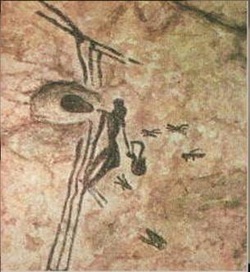 Here we see a person presumably taking honey from a wild hive. It shows us how, though these ancient people were not keeping hives themselves, they knew of the importance of the bee and of the wonderful things she could create. This is a painting from the Cuevas de la Araña (Spider Caves) in Valencia, Spain, thought to have been painted c. 8,000 years ago.2
Here we see a person presumably taking honey from a wild hive. It shows us how, though these ancient people were not keeping hives themselves, they knew of the importance of the bee and of the wonderful things she could create. This is a painting from the Cuevas de la Araña (Spider Caves) in Valencia, Spain, thought to have been painted c. 8,000 years ago.2
Ancient Egypt – an epoch of history to which I am most ardently drawn – abounds with references and depictions of humans and bees. The Egypt of the ancients is steeped in magic and mystery; it was a place and time infused with all manner of rituals and rites for life and for death. And so, it is not surprising to find that these people of olde were aware of the mystical power of the bee, as well as of the practical applications of the fruits of her hive.
The ancient Egyptians were also avid painters, and as such they have left records of parts of their lives. Among these paintings can be found those showing the tending of bees by human hand as well as the use of beeswax for painting, for cosmetics, for sculptures, and for candles.3
In these windows to the past we have found at lease one example of an ancient culture learning to live with the bee.
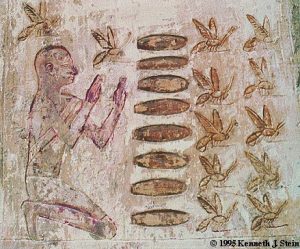 “The god Re wept and the tears from his eyes fell on the ground and turned into a bee.” From lines inscribed on a papyrus now in the British Museum. (photo: blueterracotta.com)
“The god Re wept and the tears from his eyes fell on the ground and turned into a bee.” From lines inscribed on a papyrus now in the British Museum. (photo: blueterracotta.com)
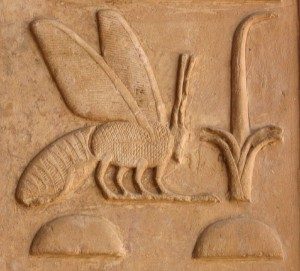 The bee can be found among the hieroglyphs of ancient Egypt, often in relation to royalty, showing us the immense importance of this small insect to this great civilization. (photo: theorangebee.com)
The bee can be found among the hieroglyphs of ancient Egypt, often in relation to royalty, showing us the immense importance of this small insect to this great civilization. (photo: theorangebee.com)
In ancient Europe people were also learning how to tend the bees. Many people through the land were trying their hand at this task, though the bulk of the beekeepers were usually those of monastic persuasion. The monks enjoyed the use of the beeswax to manufacture the many candles they needed for their religious sanctuaries. Something at which they were at fault though – no doubt because of the heedless patriarchal rule – was that they believed that large bee of the hive, who was obviously in charge, was a king, and that this king was aided by his also male attendants.4 How foolish they must have felt when they finally learned the error of their ways.
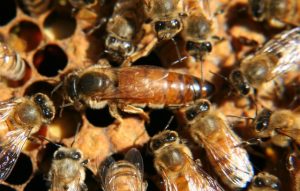 The elegant Queen with her lady attendants all around her. (photo: dailytimesgazette.com)
The elegant Queen with her lady attendants all around her. (photo: dailytimesgazette.com)
Another thread woven through the fabric of this history is spun by the various bee cults. The ancient Greeks and Cretans; people of olde Europa; ancient Egyptians; Celts and Druids; in India, Russia, and Japan; any place on Earth where bees lived, so too the bee worshipers. People have always known that the honeybee is a unique creature. Bees are inextricably worked into many culture’s mythologies and mystical rites. Temples are devoted to the goddess in her bee form and bee priestesses devote their lives to her worship.5
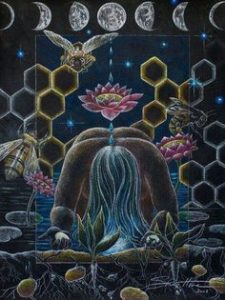 This picture expresses the mystical allure of the nature of the honeybee. It shows her connectedness to all creation – to its cycles and its seasons – and to the indomitable female presence she evokes on our planet. (photo: herebedragons.weebly.com/dragontree-e-zine.html)
This picture expresses the mystical allure of the nature of the honeybee. It shows her connectedness to all creation – to its cycles and its seasons – and to the indomitable female presence she evokes on our planet. (photo: herebedragons.weebly.com/dragontree-e-zine.html)
The honeybee is also firmly rooted in much folklore. There are a great many folktales, superstitions, and, consequently, customs that follow the honeybee. Some of these customs are still practiced today.
‘Telling the bees’ is such a custom that hails from ancient Europe and is still alive and well in present time. It entails the beekeeper keeping the bees informed about the goings on of the family – such as births, deaths, and other noteworthy events. This quaint custom derives from an old belief that bees are messengers who can travel between worlds.6
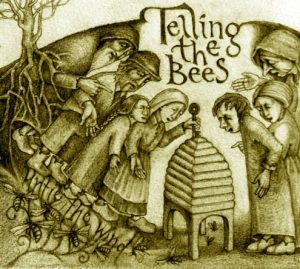 (photo: tellingthebees.co.uk)
(photo: tellingthebees.co.uk)
From the fjords of Scandinavia, to the cypress-studded hills of the Mediterranean; from the mountains of Japan, to the deserts of Africa; in all reaches of the planet, humans formed deep relationships with bees over the millennia. The honey, the wax, the propolis, and the pollen that the bees could create through their natural alchemy, has been a wonder to humans, as well as a gift. There is evidence in tombs of ancient Egypt, in cuneiform texts of Sumeria, on frescoes of ancient Greece and Crete – and many more places and times in history – of the use of honey for food and for medicine as well as the use of wax for light sources, cult objects, and cosmetics.
At present time, we are facing a dire chapter in the long tale of the honeybee. With the terror of monocropping and poisonous agricultural practices – not to mention the shifting climates brought about by global warming – the bees are struggling for survival in a way they never have before. Lucky for the bees – and for us as well – there are many people who are once again taking up an interest in this most important occupation of tending bees. This renaissance of bee tending could only bring with it more fortunate times. The health of the bees denotes the health of the planet.
A very special part of our relationship with honeybees is that, even in our company, they will forever remain wild creatures. They are free to leave at any time – and some do. They are not kept in cages and they are domesticated only in that they are familiar with the company of humans. Yet wild they will always be, and to spend our time around them is a great gift to us. We would do well to honor her-story, and to ensure long and healthy further chapters in that wondrous tale.
In my journey of this research, it has become clear to me that there was no true beginning of beekeeping as we now know it: as a deliberate and intentional act of tending bees in order to care for their colonies and to obtain the products thereof. There is no one place or time where it began. Instead, it seems that the origin of this relationship is as yet unknown, as with many things we now take for granted such as agriculture, building techniques, and structures of communities, to name just a few. However, what we can be sure of is that it is something which has grown and transformed over the centuries. Through scientific means, new evidence of the relationship between bees and humans is being uncovered, giving us glimpses of how this relationship has unfolded, and yet also reminding us that by working with these creatures we are engaged in an age old legacy of keeping company with bees.
 (photo: http://www.medievalists.net/2015/06/21/medieval-beekeeping/)
(photo: http://www.medievalists.net/2015/06/21/medieval-beekeeping/)
References
- bris.ac.uk/news/2015/november/honeybees-and-neolithic-farmers.html
- http://beesinbicorp.weebly.com/
- http://www.historytoday.com/reviews/beekeeping-ancient-egypt
- http://www.medievalists.net/2015/06/21/medieval-beekeeping/
- http://mirrorofisis.freeyellow.com/id576.html
- https://en.wikipedia.org/wiki/Telling_the_bees
November 12, 2020 at 11:32 pm
Informative article. Thank you!